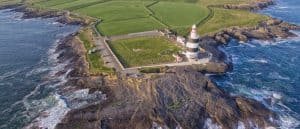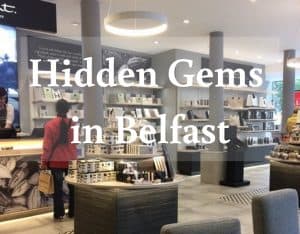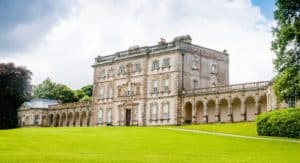Comparative Analysis of Celtic and Galician Folklore: Unveiling Cultural Intersections

Updated On: April 22, 2024 by Maha Yassin
In our comparative analysis of Celtic and Galician folklore, we explore the historical intertwining of these rich cultural heritages. Despite the geographic distance, the folklore of Galicia, a region in northwestern Spain, shares a fascinating resonance with the broader Celtic world. This connection sparks interest in considering the mutuality of myths, legends, and cultural practices that have traversed time and space. Our exploration delves into the traditions and narratives imprinted on these cultures’ collective memory, seeking to unravel the layers of history that have contributed to their contemporary manifestations.
Understanding the Celtic influences upon Galician folklore requires an examination of historical context, linguistic ties, and shared mythologies that have sculpted social identities within these communities. The melodic footprints of musical heritage, the rich tapestries of literary contributions, and the enduring symbolism found in Celtic and Galician artefacts offer a window into the past. As we conduct this analysis, we consider the historical parallels and the contemporary connections that continue to link Galicia with the Celtic nations, revealing the vibrancy of these cultures in today’s globalised world.
Historical Context

In examining the rich tapestry of Celtic and Galician folklore, we must first anchor our understanding in the historical development of these intertwined cultures.
Origins of Celtic and Galician Cultures
The Celts represent a group of tribal societies tied together by similar language, culture, and social structure, originating in the heart of Europe around 1200 BCE. Their expansion reached the British Isles, where Scotland and Ireland became notable centres of Celtic activity. This sprawling influence left an imprint of Celtic heritage, resonating through the history and folklore of these regions.
The Celtic Influence in Galicia
Galicia, tucked away in northwestern Spain, houses an intriguing blend of cultures with a unique historical narrative. Evidence of Celtic presence is marked by ancient castros—hill-fort settlements indicative of Celtic occupancy. While not a member of the Celtic League, an organisation that promotes the culture and languages of traditional Celtic nations, Galicia’s ties to Celtic traditions have been a subject of academic interest. Its folklore and customs echo parallels with those of historical Celtic lands, forging a cultural connection that persists.
Linguistics and Languages

In the study of folklore, language is a critical component, for it is within the linguistic fabric that the cultural essences are encoded. Understanding the linguistic traits and historical connections is essential when comparing Celtic and Galician folklore.
Celtic Linguistic Traits
Celtic languages consist of a group of languages originating from Proto-Celtic. They fall under two major categories: Continental Celtic, with extinct languages like Lepontic and Gaulish, and Insular Celtic, which includes several living languages such as Breton, Irish, Scottish Gaelic, and Welsh, alongside revived languages like Cornish and Manx. These linguistic traditions are known for their complex grammatical structures, rich phonologies, and distinctive vocabulary. For instance, modern Welsh retains its ancestors’ consonantal mutations and inflected prepositions. Efforts in language revitalisation have led to the emergence of contemporary linguistic communities, especially in regions like Brittany, Wales, and Ireland, securing the place of Celtic languages in the modern world.
Galician Language and Its Celtic Links
The Galician language, or Galego, a Romance language that evolved from the vulgar Latin brought by Roman conquerors, epitomises linguistic convergence with Celtic heritage. It shares traits with Portuguese and is integrated into the Castilian-dominated linguistic criterion of Spain. Scholars detect Celtic substratum in toponymy and some Galician words, which have no meaning in other Romance languages. Even though the influence of Celtic on Galician cannot equate to a living Celtic language status, these linguistic remnants echo a historical connection that shapes Galicia’s cultural and mythological narratives. The language debate around Galician’s Celtic connections often brings a nuanced understanding of linguistic and cultural identities within the broader scope of Galician and Celtic folklore.
Mythology and Legend
In this section, we explore the rich tapestry of Celtic myths and the unique folklore of Galicia, observing their cultural significance and the remnants of mythology that permeate the stories and traditions of these regions.
Celtic Myths
Celtic myths form a cornerstone of the cultural heritage across several European regions. These myths are known for their complex pantheon of gods and legendary heroes. One of the most notable narratives is the story of the Tuatha Dé Danann, a race of god-like figures who, according to Celtic myth, inhabited Ireland before the arrival of humans. Their tales are interwoven with elements of magic and otherworldly feats, lasting impacting the folklore of Ireland, Scotland, and beyond.
Contained within these myths are references to mystical objects such as the Lia Fáil or the Stone of Destiny, which roared under the feet of the rightful kings of Ireland. These myths are not merely stories; they are the threads that weave the historical and cultural identity of the Celtic people.
Galician Folklore and Mythology
Galician folklore and mythology, while resonating with echoes of Celtic traditions, hold a distinct place in Iberian culture. The folklore of Galicia is a treasure trove of tales featuring witches, spirits, and supernatural creatures.
Myths often feature locations like the Piedras de Abalar in Muxía, large stones considered sacred and thought to be able to reveal truths when they oscillated. We find that within these folktales, nature and the earth are not just scenic backdrops, but active participants in the mystical narrative that Galicians held dear.
The Celtic and Galician mythologies showcase the depth at which mythology and the natural world are intertwined, providing a profound understanding of the ancient peoples’ relationship with the land and the unseen.
Cultural Practices and Traditions

This section explores the vibrant cultural practices and traditions that connect the Celtic heritage with Galician folklore. Both cultural strands celebrate unique festivals and rites preserved over the centuries, intertwining historical beliefs with contemporary festivities.
Celtic Festivals
The Celtic calendar is marked with significant festivals celebrating the seasons and agricultural cycles. One of the most notable is Samhain, which heralds the beginning of winter and is considered a time when the veil between worlds is thinnest. In modern times, it is the precursor to Halloween. Additionally, Beltane, celebrated on 1 May, welcomes the start of summer with bonfires and Maypole dancing, symbolising fertility and new life.
Galician Festive Practices
Galicia, a region in northwest Spain rich in Celtic roots, boasts festivals that draw from these ancient traditions. O Festival, which takes place around the National Day of Galicia on 25 July, coincides with the religious pilgrimage of the Camino de Santiago, which ends at Santiago de Compostela. It has become a fusion of contemporary cultural expression and age-old customs. The Festival of Ortigueira, a significant event celebrating Celtic music, transforms the town of Ortigueira into a hub of cultural exchange, resonating with the music of bagpipes and traditional folk dances.
Musical Heritage
Music is a core element that connects the Celtic and Galician traditions, particularly through the use of distinctive instruments such as pipes and variations of the bagpipe.
Celtic Music Forms
Celtic music is a broad category that encompasses the folk traditions of Celtic peoples. It is known for its rich variety of melodies and the central role of instruments such as the bagpipes, which are prominent in Scotland and Ireland. These pipes produce a distinctive sound that has come to be associated with Celtic culture, used at both celebrations and ceremonial occasions. Another important characteristic is the structure of Celtic music, often composed in jigs, reels, and ballads.
The Galician Musical Scene
When examining the musical landscape of Galicia, one cannot ignore the significant influence of the Celtic heritage, particularly evident through the use of the Galician bagpipe, or ‘gaita’. The gaita is a defining feature of the region’s soundscape and bears a strong resemblance to its Celtic cousins in terms of both structure and sound. Notably, Galician music shares similarities with other Celtic regions, such as Exploring the Celtic Heritage of Galicia, which shows a common thread that weaves through their musical traditions. The Galician musical scene is also marked by the use of percussion instruments and the presence of bagpipe-led ensembles, reflecting a vibrant and enduring legacy.
Literary Contributions

In our comparative analysis of Celtic and Galician folklore, we focus on the rich literary landscapes shaped by historical narratives and linguistic threads. Notably, the literature from these regions reflects cultural identities and provides insight into the interwoven mythologies that have captivated scholars and enthusiasts alike.
Celtic Literature
Celtic Literary Heritage: Celtic literature, penned in various Celtic languages, including Gaelic, boasts profound narratives that often intertwine with myth and legend. Predominantly oral in its early forms, this literature encapsulates various genres, from epic tales to lyrical poems. The classics within this tradition have been translated into English and other languages, making the Celtic literary canon accessible to a global audience.
- Notable Works:
- The Mabinogion – a collection of medieval Welsh tales
- The Táin – an epic from Irish mythology
These texts not only delve into fantastical realms but also reflect societal values and historical events of their times.
Galician Literary Works
Galician Literary Progression: Galicia, a region with a distinct linguistic identity, contributes to the Iberian Peninsula’s rich literary tradition through works primarily in the Galician language. We see the cadence of its Celtic echoes in modern and historical texts.
- Key Periods:
- The medieval resurgence with the likes of Cantigas de Amigo
- A revival in the 19th century during the Rexurdimento or renaissance
These periods showcase the strength and resilience of Galician literature despite the challenges posed by political and linguistic suppression.
Our exploration navigates through the seminal contributions of Celtic and Galician literature, each preserving linguistic uniqueness while offering narratives that resonate universally. Through this lens, we better understand their interconnected folklore and the enduring legacy embedded within their stories.
Symbolism and Artifacts

In this section, we explore the intricate symbolism and various artefacts associated with Celtic and Galician heritage, focusing on the distinctive art and symbols they are known for and the stone and jewellery that characterise their cultural identity.
Celtic Art and Symbols
Celtic art is renowned for its complex patterns and motifs, often seen as knotwork, spiral patterns, and key patterns. These symbols can be found in various mediums, including the illustrious Book of Kells, where they adorn the pages with intricate detail. Often, Celtic symbols convey meanings such as eternity and continuity, reflecting the Celts’ deep connection with the natural world and their spiritual beliefs. Torcs, often crafted from gold or bronze, represent a type of jewellery emblematic of Celtic society, worn as a sign of nobility and status.
Galician Stone and Jewelry
In Galicia, the legacy of stone-crafting is prominent, with numerous Petroglyphs and Stele dotting the landscape. These stones often bear symbolic carvings and have been linked to the region’s Celtic heritage. Galician jewellery, particularly pieces such as torques, which are neck ornaments, reveal similarities to the Celtic counterparts, displaying intricate designs and patterns. Notably, Cape Finisterre, a rock-bound peninsula in Galicia, draws its name from the Latin ‘finis terrae’, meaning ‘end of the world’, and it is a place enveloped in myth, showcasing the types of evocative settings where such artefacts could be found.
Social Structures and Identity

In this exploration, we focus attention on the intricate tapestry of social organisation within Celtic communities and the rich cultural identity of Galicia. Distinct yet interconnected, these elements form the core of a comparative analysis that reveals a vibrant historical narrative.
Celtic Social Organisation
Celts are known to have established complex societies with well-defined roles and classes. Notable among these were the druids, respected intellectuals often seen as priests who played a pivotal role in Celtic life. Warriors held their status, owing to their part in defending territories and expanding regions, especially along the Atlantic edges. Laypersons comprised the bulk of society—farmers, artisans, and traders—each contributing to a cohesive structure sustaining Celtic culture across regions, including Brittany.
Galician Cultural Identity
In Galicia, cultural identity has similarly been shaped by a social fabric steeped in tradition and folklore. Galician culture is a proud manifestation of its own distinctive identity, where the echoes of Celtic roots are discernible in its mythologies and customs. These cultural underpinnings connect Galicians in a shared sense of heritage that aligns with the broader Celtic narrative, visibly imprinted along the windswept coasts of the Atlantic. Even as modern movements shape Galicia, this cultural consciousness remains, tying Galicians to their Celtic “brothers from the north,” such as those in Brittany.
Contemporary Connections

In this section, we explore the living cultural threads interweaving modern Celtic communities with the active resurgence of Galicia’s Celtic heritage. These connections illuminate the historical ties and the contemporary efforts to celebrate and revitalise ancient traditions and cultural identity.
Modern Celtic Communities
In various parts of the world, particularly in regions such as Brittany, Scotland, Ireland, and Wales, modern Celtic communities are thriving. These groups promote Celtic culture, languages, and music through organisations like the Celtic League. Annual events such as the Pan Celtic Festival showcase the vibrancy of these traditions through competitions, concerts, and cultural exchanges. This festival is a significant example of the cultural solidarity and heritage-sharing that characterises the Celtic community worldwide.
Galicia’s Celtic Revival
Galicia, a region in northwestern Spain, has experienced a cultural revival of its Celtic connections. The Galician Celtic Revival is characterised by a growing interest in the region’s ancient heritage, reflected in music, folklore, and festivities. The city of Lugo, known for its Roman walls, annually celebrates the Arde Lucus festival, where the town revives its Roman and Celtic past, highlighting the crossroads of cultures that define Galicia’s history. Local artists and musicians integrate Celtic symbols and sounds into their work, affirming their ancestral legacy through contemporary creative expressions.
Linguistic and Cultural Analysis

This section explores the interconnections between the Celtic and Galician languages and cultures through a focused lens of linguistics and comparative cultural studies.
Analytical Theories in Linguistics
Analytical theories in linguistics are vital in dissecting the structural components that contribute to the similarities and differences between languages. When examining the Celtic languages, we notice a range of features they share, often pointing to a common Indo-European heritage. A particular interest in anthropology and sociology brings into view the application of these structural theories to societal contexts.
Comparative Cultural Studies
Our attention to comparative cultural studies helps us articulate how Galician folklore holds its place within the tapestry of Celtic nations. The folklorist approach unveils shared cultural elements by weaving through patterns in mythical motifs and oral traditions. This comparative analysis stretches beyond surface-level observations, fostering a nuanced appreciation of the interplay between different cultures.
Global Perspectives

In exploring Celtic and Galician mythology, we uncover their impact on wider cultures and how they intertwine with broader social narratives.
Celtic Influence Worldwide
The Celts have left a significant mark across various regions beyond their historical homelands. Celtic mythology remains a deeply ingrained part of the cultural identity in Ireland and Scotland, with epic tales of heroes like Cú Chulainn and the legend of the Loch Ness Monster. The culture extends to places like Cornwall and the Isle of Man, where similar stories echo the ancient Celtic spirit. However, the Celtic influence goes further; regions such as Asturias in Spain and even far-flung diaspora communities worldwide continue to celebrate their Celtic links through music, dance, and folklore festivals.
- Irish: St. Patrick’s Day celebrations around the globe
- Scottish: Highland games and Burns Night
- Breton: Fest Noz and other cultural revival movements
- Cornish: St. Piran’s Day and Cornish language revival
Galicia and the Broader Spanish Context
In Galicia, the presence of Celtic heritage distinguishes it within the broader Spanish cultural landscape. Despite its location in northwestern Spain, Galician folklore and traditions—such as the queimada ceremony and gaita music—resemble those of other Celtic nations and draw interest in the region’s historical connection to the Celts. This unique cultural tapestry has even led to debates regarding Galicia’s status within the pan-Celtic community. It is a region where the past and present merge, creating a distinctive identity that stands out amidst the rich diversity of Spanish customs.
- Galician: Gaita music and the ‘Noite de San Xoán’ celebrations
- Spanish: Juxtaposition of Galicia’s distinct culture against flamenco and bullfighting
Frequently Asked Questions

In this section, we address common inquiries about the interplay between Celtic and Galician folklore, exploring Celtic influences in Galician culture, mythology, traditions, and symbolism.
How do Celtic influences manifest in Galician folklore?
Celtic echoes in Galicia are evident through rich myths and legends, such as tales of witches and enchanted forests where spirits are said to roam, all steeped in mysticism reminiscent of Celtic folklore.
What similarities exist between Celtic and Galician mythological creatures?
The Galician rolda, a ghostly figure signalling death, mirrors similar creatures in Celtic mythology, underscoring the common mythological roots the cultures share.
In what ways has the gaita contributed to Galicia’s Celtic cultural heritage?
The gaita, a bagpipe-defining element of Galician music, reflects Galicia’s Celtic cultural heritage and is central to traditional folk music, closely related to its Celtic counterparts.
Which aspects of Galician folklore reflect Celtic tribal customs?
Galician folklore exhibits Celtic influence through its tribal customs, such as communal gatherings, oral storytelling, and celebrations of nature that resonate with those of ancient Celtic societies.
How have Celtic symbols been integrated into Galician heritage?
Celtic symbols are integrated into Galician heritage in architecture, jewellery, and religious iconography, with spirals, knots, and crosses echoing a shared Celtic past.
What role does storytelling play in preserving Celtic elements in Galician traditions?
Storytelling is a vital tradition that aids in preserving Celtic elements within Galician culture, with poems and tales passed down through generations highlighting common thematic threads with the Celtic narrative tradition.






